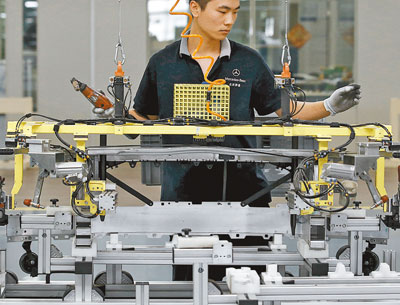
CHINA looked set for a soggy start to 2016 after activity in the manufacturing sector contracted for a fifth straight month in December, suggesting the government may have to step up policy support to avert a sharper slowdown.
While China’s services sector ended 2015 on a strong note, the economy still looked set to grow at its slowest pace in a quarter of a century despite a raft of policy easing steps, including repeated interest rate cuts, in the past year or so.
The world’s second-largest economy faces persistent risks this year as leaders have pledged to push “supply-side reform” to reduce excess factory capacity and high debt levels.
The official manufacturing Purchasing Managers’ Index (PMI) stood at 49.7 in December, in line with expectations of economists polled by Reuters and up only fractionally from November. A reading below 50 suggests a contraction in activity while a higher one indicates an expansion.
Still, economists seemed to find some comfort that there were no signs of a sharper deterioration which has been feared by global investors.
The slight pick up in the manufacturing PMI “suggests that (economic) growth momentum is stabilizing somewhat ... however, the sector is still facing strong headwinds, said Zhou Hao, China economist at Commerzbank in Singapore.
“In order to facilitate the destocking and deleveraging process, monetary policy will remain accommodative and the fiscal policy will be more proactive.”
Weak demand from at home and abroad has weighed on China’s factories, exacerbating the problem of excess capacity and forcing them to cut prices of their goods, eating into their profits and adding to deflationary pressures in the economy.
Total new orders — a proxy for both domestic and foreign demand — rose to 50.2 in December from November’s 49.8, the PMI survey showed.
But export orders shrank for the 15th straight month, albeit at a less severe pace. The sub-index inched up to 47.5 from November’s 46.4.
The National Bureau of Statistics (NBS) said that although oil prices were very low at present, cash at the end of the year was tight for factories, putting relatively large pressure on manufacturers.
China’s economic growth is expected to cool from 7.3 percent in 2014 to 6.9 percent in 2015, the central bank said in a recent work paper, its slowest pace in 25 years. It said growth could ease further to 6.8 percent in 2016.
Leaders at the annual Central Economic Work Conference last month pledged to make monetary policy more flexible and expand the budget deficit in 2016 to help underpin growth and reforms.
Indeed, China could run its biggest budget deficit in half a century this year as leaders turn to more government spending to arrest the slowdown in the economy, policy advisers say, after disappointing returns from a year of policy easing.
The central bank has cut interest rates six times since November 2014 and reduced banks’ reserve requirement ratios (RRR), or the amount of cash that banks must set aside as reserves. The government has also stepped up spending on infrastructure projects and eased restrictions on home buying to boost the sluggish property market.
The central bank is widely expected to cut interest rates and banks’ reserve requirement ratios further this year.
A similar official survey on the services sector showed activity in China quickened in December, again helping to ease fears of a hard landing for the economy this year.
The services sector has been the lone bright spot in the economy in the last few years, helping to offset prolonged weakness in the vast manufacturing sector, though financial markets tend to focus more closely on factory readings.(SD-Agencies)
|

